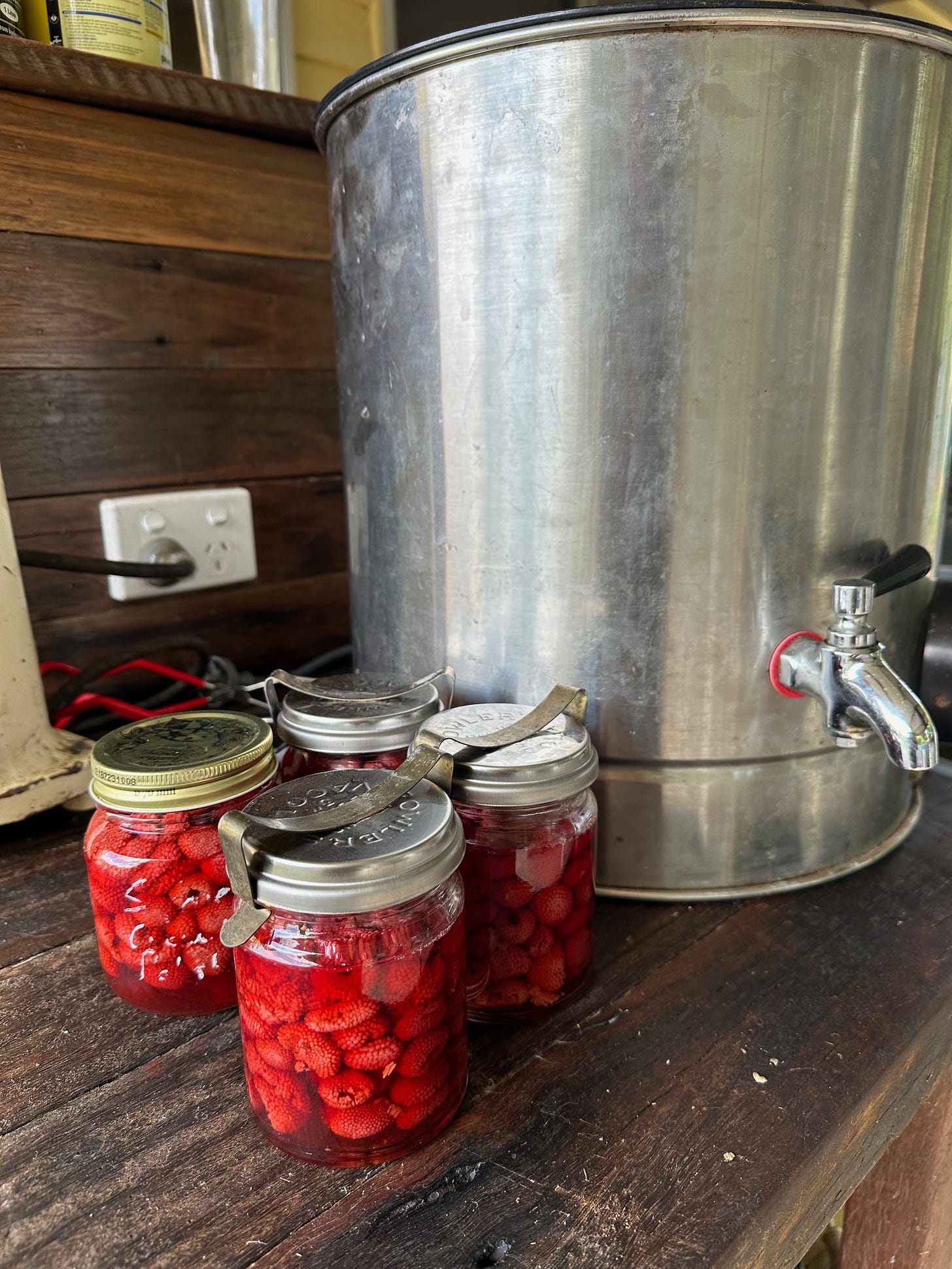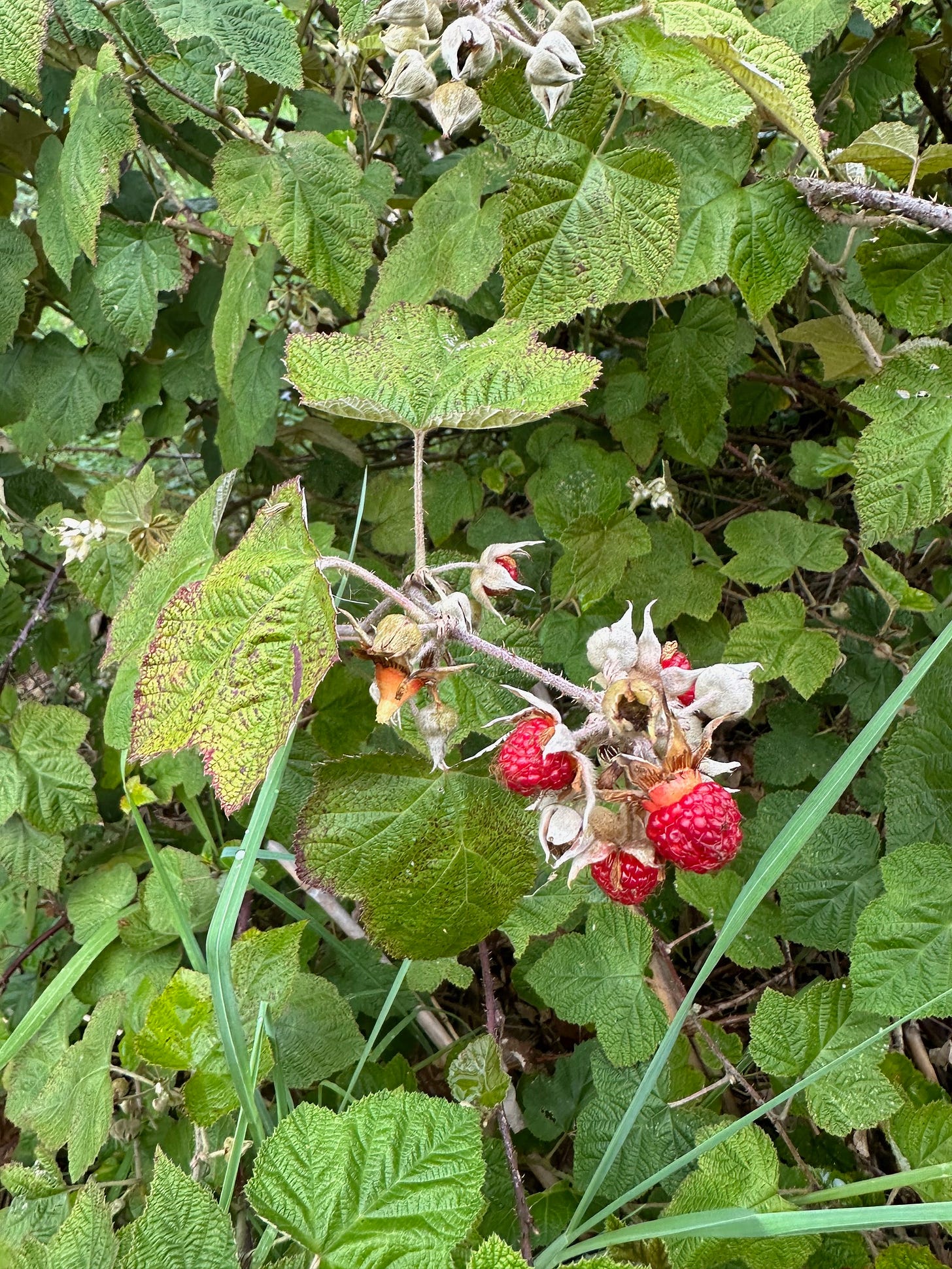When we first moved to Serenity, I put a lot of effort into getting a garden started and growing food. We had some existing fruit trees - mostly citrus and some bananas, and the plan was to plant more. While I can grow some sort of vegetables all year long, it’s hard to have fruit in season throughout the year. We’re slowly getting there, but still have a way to go. I’ve since planted many different trees - mango, lychee, tropical apple, nectarine, peach and cherry, mangosteen, mulberry, sapote and more!
Fruits that I really wanted to get established was berries and this year (year 3) we are finally harvesting some. I planted a heap of strawberry runners last year and we’ve been picking strawberries since mid winter. Raspberries have been pretty good too and still coming on. We planted one raspberry cane in a garden bed out the back of the house and it was just taking over, which I realise they are prone to do. I didn’t realise at the time of planting, but once the huge bush started fruiting, I discovered that it was the same as the native raspberry that we have out in the paddock. I didn’t want to keep it, but it was huge and I didn’t know how to get rid of this prickly monster.
Along came our pigs, this was where we first put them and they did a fabulous job of cleaning out the raspberries. That area has since grown a fantastic potato crop and now has rockmelons (cantaloupe) planted. We have also harvested some raspberries from the wild patch that took no work to maintain!
The wild native raspberry patch is huge!
I’m guessing that this is an Atherton Raspberry rubus probus but I’m not really sure. It’s not super juicy but does have a nice flavour. I wasn’t over fussed on it when it was in the garden because it wasn’t good enough to take up that much space, but out in the paddock it’s certainly worth harvesting. And when you cook them, the flavour is enhanced. I cooked up some with a little sugar and they were really good on some natural yoghurt! So I decided to preserve some. I filled jars with them, added a teaspoon of sugar and topped up with water. I used my new to me electric Fowlers Vacola preserver (thanks Shan) and did them the fowlers way. If you aren’t an Aussie, you may not have heard of this type of preserving, but it’s similar to water bath but not as hot and for longer. It’s only safe for high acid fruits.
The other native raspberry I have in the garden is called rubus moluccanus and it is much more like what I think a raspberry should be like, although it is smaller. I only have the one bush of it, but it’s also looking like taking over so I might have to work out how to manage it. These are sweeter and juicer than the wild one.
There is also a patch of some other sort of bramble berry but it's in a spot that the goats can access when they’re in their holiday paddock so I haven’t had much fruit from it yet and don’t really know what it is.
Another fruit we have is called Brazilian Cherry (also called Suriname Cherry) Eugenia Uniflora. Calling it a fruit is a bit generous! It’s quite tart and has an unusual flavour, so not very nice eating. The one I’m harvesting from at the moment was originally here, but I’ve since planted a few more. The goats also like them and this one is also in the goat holiday paddock! The reason this tree earns a place on the farm is that the fruit makes a very good substitute for tomatoes in tomato sauce (ketchup). I have a very simple tomato sauce recipe that I usually do in the thermomix. Tomato sauce is something we always have on hand because I have a husband who can’t eat a sausage without sauce on it!
I would make this exact same recipe with tomatoes and it’s a really good sauce. It keeps well. I used to make a huge pot of it when I could get 5 kg’s or more, but my tomato growing is not so good these days so I just make a small batch when I get enough tomatoes - usually just the small cherry tomatoes.
Nomato Sauce (ketchup)
Ingredients
• 1kg Brazilian Cherries
• 165g vinegar – use whatever vinegar you like. I either use white or ACV
• 165g sugar
• 2og salt
• 2 cloves fresh garlic
• Chilli to taste, optional
• 1/16 teaspoon each of the following: ground allspice. ground cloves, ground ginger
• 1/8 teaspoon of white pepper
Method
1. Place everything in a saucepan (or thermomix) and cook for about half an hour
2. Press through a strainer to remove the seeds
3. If it doesn't look thick enough, put back into the saucepan and boil until it is.
4. Pour into sterilised bottles and seal.
Once they've cooled, make sure the bottles have sealed by checking that the lids have been sucked in. If not sealed, store in the fridge otherwise store bottles in the pantry.







It sounds like fruit paradise up your way! Chocolate Sapote, lychee, mangoes and berries galore! Down here, I am not so patiently waiting for our little white raspberries to turn red. A highlight of our much shorter fruiting calendar.